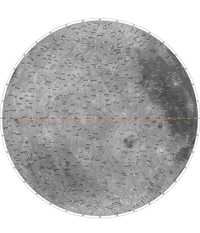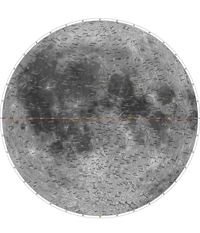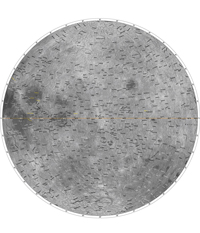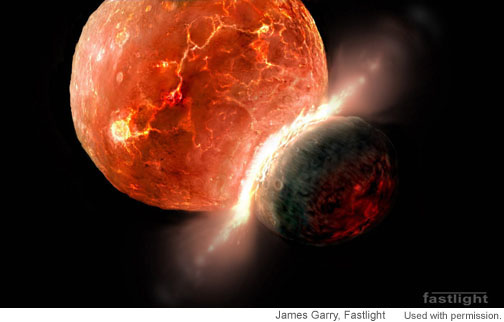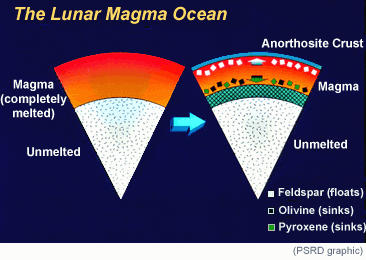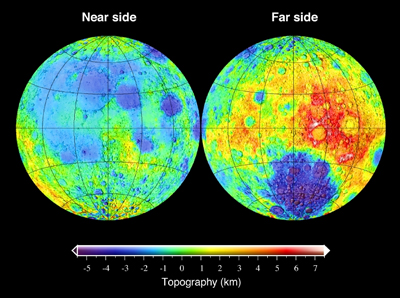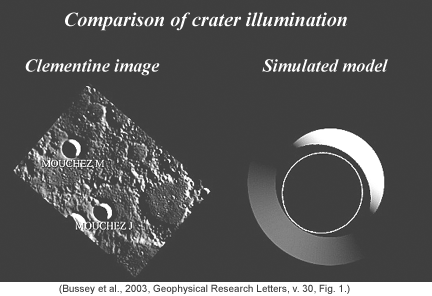|
Mainland High School
Cutting the Cord: ISTF 07-1726 |
|||||||||||||||||||||
|
Home
Introduction Components One Two  Product Product
Three Microwave Research W. C. Brown Generators History Phased Arrays Properties Rectennas Semiconductors Solar Satellites Superconductors Moon Research Colonization Helium-3 Fusion Geography Mining Resources Project Assessment Bibliography Glossary Team |
Geography of the Moon
There are three sides to the moon that are visible to us on earth: the near side of the moon, the western far side, and the eastern far side. The side of the moon that is the most valuable to our project is the near side of the moon since it faces the earth at all times and contains four of the five largest seas/oceans on the moon. These seas/oceans are:
The moon itself is mountainous and full of craters. 500 kilometers below the surface of the moon lies the lava ocean, which is not like the lava found on the earth, but instead is frozen solid. Cosmochemists believe that towards the end of Earth's formation, when Earth was still a large plasma spheroid, a large solar object, roughly the size of Mars, crashed into the earth, forming what is now our moon. Below its crust there is a layer of frozen magma, called the magma ocean. The origin of this magma ocean comes from the fact that the moon was once a part of the earth, the reason the composition of the moon and Earth are similar. There are three portions to the composition of the moon, the crust, mantle, and core, it is very much like that of the earth. The crust of the moon is approximately 43 miles thick. The mantle is rich in magnesium and iron. It also contains a magma ocean. The final portion of the moon is the core, which is about 250 miles. The radius of the moon is approximately 1080 miles thick. The gravity on the moon is approximately 1.62 m/sec2, or 1/6th that on earth. The surface of the moon is littered with craters and mountains that were formed when large asteroids collided with the moon. The size of the widest crater, Clavius, is about 230 kilometers with walls over 4 kilometers high; the tallest mountain, Mons Huygens, is 4.7 kilometers above the lunar surface; and the deepest crater, Newton, is approximately 8.8 kilometers below the lunar surface. The actual topography of the moon is measured from Earth using laser altimetry and stereo image analysis. On the moon the most commonly noted feature is the South Pole-Aitken basin, which is the lowest point on its surface. Coincidentally, the highest elevations on the moon are located in the northeast portion of this basin. The moon's orbit is very close to being circular with an eccentricity of approximataly 0.0549 yielding an average moon-to-earth radius is approximately 384,000 kilometers. The moon rotates on its axis once every 27.3 days or approximately 27 days 7 hours and 43.1 minutes - the same time that it takes to make one revolution/orbit around the earth. Consequently, even though the moon rotates the same part of the moon faces the earth at nearly all times. This is called synchronous rotation.
The moon's average orbital speed is 2287 mph. The moon does not rotate around the earth on the equatorial plane, it rotates along the ecliptic plane which is the main inclination of the lunar orbit. This inclination is roughly five degrees. 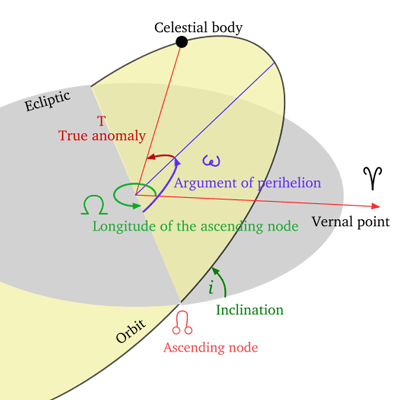
Image courtesy of Arpad Horvath This image is licensed under the Creative Commons Attribution-Share Alike 2.5 License The water on the moon is stored in a frozen state at the dark, shadowed poles of the moon which never see the warmth of the sun as a result of the moon's rotation and orbit. The craters in the north pole are almost completely dark and researchers are studying their properties to learn how much hydrogen, hopefully in the form of water ice, could be found in these "cold traps." Apollo: The Next Generation Return to the Moon - Moon Facts http://www.spacegrant.hawaii.edu/futureflight/ffh2001/MoonFAQs/deepcrat.htm Astronomy for Families - Moon Struck http://www.geocities.com/Heartland/fields/8616/moonfacts.html Keith's Moon Page - Facts, Phases, Photoes & Folklore http://home.hiwaay.net/~krcool/Astro/moon/ Fourmilab - Lunar "seas" (Mare) and "Oceans" (Oceanus) http://www.fourmilab.ch/earthview/lunarform/maria.html Internet Encyclopedia of Science - Celestial Mechanics http://www.daviddarling.info/encyclopedia/S/synchronous_rotation.html Merlin Science - The Lunar Landscape http://www.synapses.co.uk/astro/moon3.html NASA - Moon Fact Sheet http://nssdc.gsfc.nasa.gov/planetary/factsheet/moonfact.html Planetary Science Research Discoveries - The Moon's Dark, Icy Poles http://www.psrd.hawaii.edu/June03/lunarShadows.html Planetary Science Research Discoveries - Two Views of the Moon's Composition http://www.psrd.hawaii.edu/April07/Moon2Views.html Ralph Aeschliman Planetary Cartography and Graphics - Lunar Maps http://ralphaeschliman.com/id26.htm Universities Space Research Association - Intern LPIB Issue 75, Spring 1995 http://www.lpi.usra.edu/publications/newsletters/lpib/lpib75/bull5.html University of Tennessee Knoxville - Orbit and Phases of the Moon http://csep10.phys.utk.edu/astr161/lect/time/moonorbit.html Wikimedia Commons - Image:Orbit.svg http://commons.wikimedia.org/wiki/Image:Orbit.svg Wikimedia Commons - Image:MoonTopoGeoidUSGS.jpg http://commons.wikimedia.org/wiki/Image:MoonTopoGeoidUSGS.jpg Wolfram Research - Moon http://scienceworld.wolfram.com/astronomy/Moon.html World Book at NASA - Moon http://www.nasa.gov/worldbook/moon_worldbook.html |
||||||||||||||||||||
